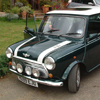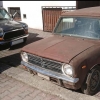Being electronic engineer student, could i suggest for prototyping using just a strip board? instead of PCB, etching is a pain, and if you can give me something to work with i could also get a Printed Circuit Board, using an etching printer, I have used it before to make PCB boards for Amps and Guitar pedals.
I just stumbled apon this post because i saw the Savage switches and thouigh they would look sick! But i dont have much knowledge of how they work or what problems people are coming into.
Ill keep searching around and seeing what can be done.
But meanwhile, if anyone has a simple circuit that will work, that just needs putting onto a board, let me know.
Also, i have considered for a while now to use an Arduino or even a rasberry Pi to program some things in the mini, like interior lighting, automatic side lights and a few other things, but just havnt had time to take a good look at it. I have used Arduinos and Rasberry Pi's a lot so know a good amount, so if anyone has any ideas throw them at me, i may open another thread about this, see what ideas people have :)




















